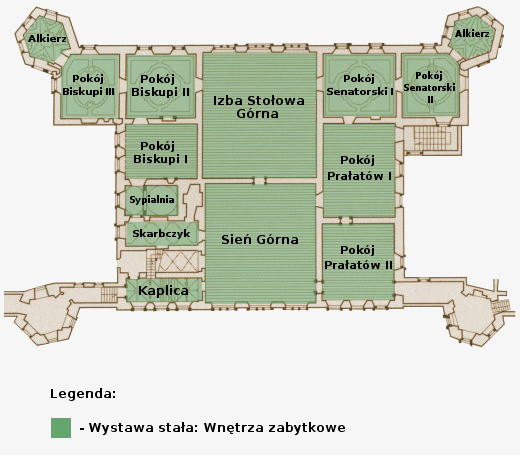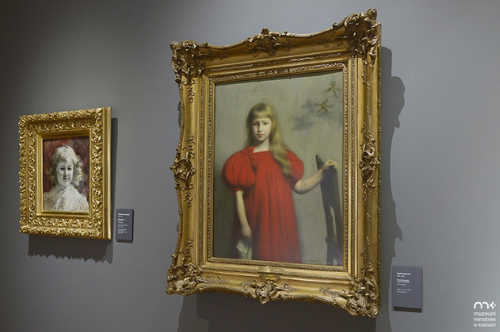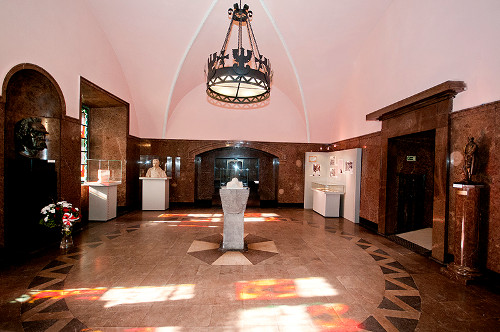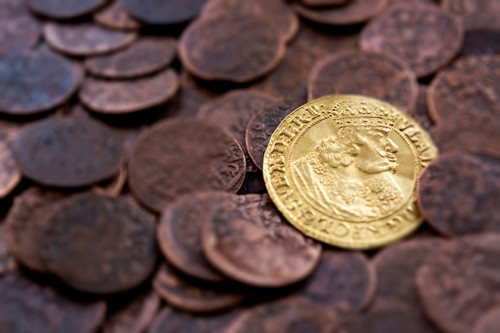Historical interiors - 17th and 18th c.

The permanent exhibition is organized on the first floor of the 17th-century Cracow Bishops’ Palace. One may see there precious decorative arts objects and a unique set of portraits of the representatives of Polish gentry in the Upper Hall.
Another valuable element of decoration is huge French tapestry from the half of 18th c. made according to the painting by famous Charles Le Brun - “The Battle of Alexander the Great with Persians at the Granicus River”. In the same chamber we may also admire German furniture of an extraordinary artistic class level – a pair of inlaid dowry chests (Franconia, 1580-1590) with excellent inlaid decoration, a hunter’s chest (beginning of the 17th c.), two hall wardrobes (Frankfurt, 17th/18th c.), and finally, a south German wardrobe with rich figural, animal and floral inlay (1st half of the 18th c.). There is also a so-called Gotic chair from Sancygniów with Dębno coast of arms, the monogram HK of its author (Hans Kuntz from Cracow) and the date 1588.
Read more
The Gallery of Polish Painting and Decoration Art
 The Gallery is located in the north wing of the palace. It consists of the collection of 17th-18th-century Polish portraits (e.g. Soltyk, Wielopolski and Jablonowski families) and 19th century landscape and genre painting, including works by F. Kostrzewski, J. Szermentowski and W. Malecki. Among Malczewski’s paintings of partcular interest are symbolical and allegorical representations - „Polonia” and „Self-Portrait in Armour” A great pride of the exhibition is „A portrait of a Girl in a Red Dress” by J. Pankiewicz, an outstanding representative of Polish modernism. The corner of the room is devoted to the Young Poland painting from the 19th c. and its main representative S. Wyspianski. Portraits and landscape paintings of other contemporary Cracow artists are also displayed: L. Wyczolkowski, W. Wojtkiewicz. The Gallery ends with a display of modern art.: expressionism (formism), Art Deco and numerous groups under the influence of French painting. The Gallery comprises over 500 works of decorative art, mostly pottery (faience, Meissen, Cmielow porcelain, Chinese and Japanese goods), and glassware art. The metalwork on display comes from German centres, Poznan, Gdansk, Silesia and Warsaw.
The Gallery is located in the north wing of the palace. It consists of the collection of 17th-18th-century Polish portraits (e.g. Soltyk, Wielopolski and Jablonowski families) and 19th century landscape and genre painting, including works by F. Kostrzewski, J. Szermentowski and W. Malecki. Among Malczewski’s paintings of partcular interest are symbolical and allegorical representations - „Polonia” and „Self-Portrait in Armour” A great pride of the exhibition is „A portrait of a Girl in a Red Dress” by J. Pankiewicz, an outstanding representative of Polish modernism. The corner of the room is devoted to the Young Poland painting from the 19th c. and its main representative S. Wyspianski. Portraits and landscape paintings of other contemporary Cracow artists are also displayed: L. Wyczolkowski, W. Wojtkiewicz. The Gallery ends with a display of modern art.: expressionism (formism), Art Deco and numerous groups under the influence of French painting. The Gallery comprises over 500 works of decorative art, mostly pottery (faience, Meissen, Cmielow porcelain, Chinese and Japanese goods), and glassware art. The metalwork on display comes from German centres, Poznan, Gdansk, Silesia and Warsaw.
The Sanctuary of Marshal Joseph Pilsudski

The Sanctuary of Marshal Joseph Pilsudski and the Museum of Polish Legions is situated in three ground-floor rooms of the Kielce Palace. The sanctuary was initiated with due ceremony on 2 October 1938 by Kielce province governor, dr Władysław Dziadosz – an ex-soldier of the 5th legions infantry regiment.
In August and September 1914 the palace became a headquarter of Józef Piłsudski, a seat of the Temporary Office of the Polish Army, a recruitment office, the print shop, editorial office of “Polish Army Official Journal”, field post office, a pass desk and a commissariat.
Architectural, painterly and sculpting design was entrusted to Stanisław Rzecki – a sculptor and Wacław Borowski – a painter. They did the adaptation work together with dr Andrzej Oleś – a provincial conservator and Wincenty Skuczyński – a sculptor. The concept of the Sanctuary arrangement was approved by the Artistic and Conservation Council of Kielce Town. Sanctuary had its own entrance from the southern yard. Above the sandstone portal there would be a coat of arms decorated with an eagle – a riflemen’s symbol, letter “S” and initials “JP”. The entrance is decorated with the medals of 1st Brigade: “For the faithful duty”, Legions’ Crosses and the general’s way line. Door handle is in the shape of the eagle’s head. Above the entrance there is hewed a quotation from the poem “Beniowski” by Juliusz Słowacki. Very similar symbols are used to decorate three windows in the western front of the palace.
Read more
The Numismatic collection

The Numismatic Cabinet is a permanent exhibition based on the collections of the National Museum in Kielce. It exhibits coins and banknotes that were in circulation in the historical northern Małopolska region. An emphasis has been put on the treasures found in the Świętokrzyskie region, including those from ancient times and the middle ages, as well as modern times. It consists of over twenty-two thousand objects and forms a starting point of the history of money on our lands. The Numismatic Cabinet also displays a legal tender from the times of the Piast and Jagiellonian dynasties, as well and coins from the Vasa period, temporally connected with the Former Palace of Cracow Bishops – a division of the National Museum in Kielce. Exhibits documenting a wider context of the history of the country will surely be of interest to the visitors. They include a true rarity, a two zloty coin from the time of the Duchy of Warsaw minted during the siege of Zamość in 1813. The exhibition also highlights banknotes, which are small works of art designed by famous artists. The role and evolution of money, told through the prism of homeland history, will lead the visitor through to the 1990s.
Project implemented with the National Bank of Poland as part of the Economic Education program.



 The Gallery is located in the north wing of the palace. It consists of the collection of 17th-18th-century Polish portraits (e.g. Soltyk, Wielopolski and Jablonowski families) and 19th century landscape and genre painting, including works by F. Kostrzewski, J. Szermentowski and W. Malecki. Among Malczewski’s paintings of partcular interest are symbolical and allegorical representations - „Polonia” and „Self-Portrait in Armour” A great pride of the exhibition is „A portrait of a Girl in a Red Dress” by J. Pankiewicz, an outstanding representative of Polish modernism. The corner of the room is devoted to the Young Poland painting from the 19th c. and its main representative S. Wyspianski. Portraits and landscape paintings of other contemporary Cracow artists are also displayed: L. Wyczolkowski, W. Wojtkiewicz. The Gallery ends with a display of modern art.: expressionism (formism), Art Deco and numerous groups under the influence of French painting. The Gallery comprises over 500 works of decorative art, mostly pottery (faience, Meissen, Cmielow porcelain, Chinese and Japanese goods), and glassware art. The metalwork on display comes from German centres, Poznan, Gdansk, Silesia and Warsaw.
The Gallery is located in the north wing of the palace. It consists of the collection of 17th-18th-century Polish portraits (e.g. Soltyk, Wielopolski and Jablonowski families) and 19th century landscape and genre painting, including works by F. Kostrzewski, J. Szermentowski and W. Malecki. Among Malczewski’s paintings of partcular interest are symbolical and allegorical representations - „Polonia” and „Self-Portrait in Armour” A great pride of the exhibition is „A portrait of a Girl in a Red Dress” by J. Pankiewicz, an outstanding representative of Polish modernism. The corner of the room is devoted to the Young Poland painting from the 19th c. and its main representative S. Wyspianski. Portraits and landscape paintings of other contemporary Cracow artists are also displayed: L. Wyczolkowski, W. Wojtkiewicz. The Gallery ends with a display of modern art.: expressionism (formism), Art Deco and numerous groups under the influence of French painting. The Gallery comprises over 500 works of decorative art, mostly pottery (faience, Meissen, Cmielow porcelain, Chinese and Japanese goods), and glassware art. The metalwork on display comes from German centres, Poznan, Gdansk, Silesia and Warsaw.







